Introducing Draw
- Chapter 1: Introducing Draw
This is Chapter 1 of OpenOffice.org 2.x Draw Guide (second edition), produced by the OOoAuthors group. A PDF of this chapter is available from the OOoAuthors Guides page at OpenOffice.org.
Contents
Introduction
Draw is a vector graphics drawing tool, although it can perform some operations on raster graphics (pixels). It offers a series of powerful tools that enable you to quickly create a wide variety of graphical images.
Vector graphics store and display a picture as simple geometric elements (lines, circles, polygons, etc) rather than as a collection of pixels (points on the screen). This permits simpler storage and supports precise scaling of the picture elements.
Draw is fully integrated into the OpenOffice.org suite, and this makes exchanging graphics with all components of the suite very easy. For example, if you create an image in Draw, reusing it in a Writer document is as simple as copy and paste. You can also work with drawings directly from within Writer or Impress, using a subset of the functions and tools from Draw.
Draw’s functionality is extensive and even though it was not designed to rival high-end graphics applications, it possesses significantly more functionality than the drawing tools that are generally integrated with office productivity suites.
A few examples of the drawing functions are: layer management, magnetic grid-point system, dimensions and measurement display, connectors for making organization charts, 3D functions enabling small three-dimensional drawings to be created (with texture and lighting effects), drawing and page style integration, and Bézier curves.
The Draw Guide is not a course book which must be worked through from beginning to end. Rather it is a reference work in which you can browse for guidance on particular topics.
This document describes only the functions associated with Draw. Some notions, such as file management or the way the OpenOffice.org environment works, are mentioned only briefly as they are covered in the Getting Started guide.
The Draw workplace
The main components of the Draw interface are shown in Figure 1.
The large area in the center of the window is where the drawings are made. It is surrounded by toolbars and information areas. The number and position of the visible tools are variable as a function of the task at hand, or user preferences, so your setup may look a little different. For example, many people put the main Drawing toolbar on the left-hand side of the workspace, not at the bottom as shown here. The setup procedure is described in detail in Chapter 4 (Menus and Toolbars) in the Getting Started guide.
You can split drawings in Draw over several pages. This is used mainly for production of drawings for presentations. The Pages pane, on the left side of the Draw window in Figure 1 gives an overview of the pages you have created. Changes to the page order can be made easily by dragging and dropping a page or pages.
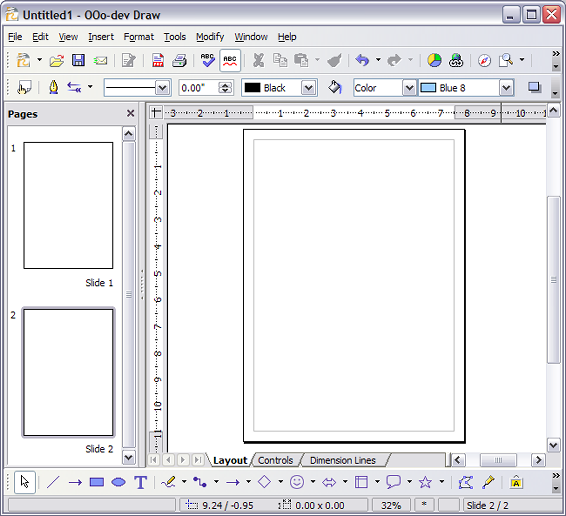
Figure 1: Initial Draw window.
Rulers
You should see rulers (bars with numbers) on the upper and left-hand sides of the workspace. If they are not visible, you can show them by clicking View > Ruler.
The rulers show the size of a selected object on the page (see the gray double lines highlighted in Figure 2). When no object is selected they show the location of the mouse pointer, which assists with the accurate positioning of drawing objects.
The rulers also are used to manage object handles and guide lines that make positioning objects easier.
The page margins in the drawing area are also represented on the rulers. You can change the margins directly on the rulers by dragging them with the mouse.
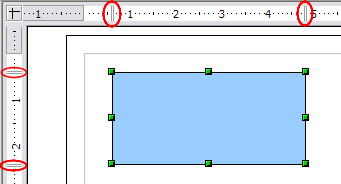
Figure 2: Rulers show size of selected object.
To modify the units of measurement of the rulers – which are independently definable – right-click on the desired ruler, as illustrated for the horizontal ruler in Figure 3.
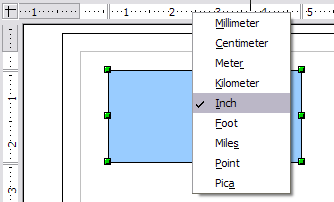
Figure 3: Rulers in a drawing.
Status bar
The Status bar is located at the bottom of the screen, as with all OpenOffice components, and includes several Draw-specific fields identified in Figure 4.
The Information field shows which action is being carried out, or which object type has been selected.
The Position field shows different information depending on whether objects are currently selected or not:
- When no object is selected, the left number pair shows the current position (in X,Y coordinates) of the mouse cursor.
- While an object is being resized with the mouse, the right number pair shows the size of the object (width x height).
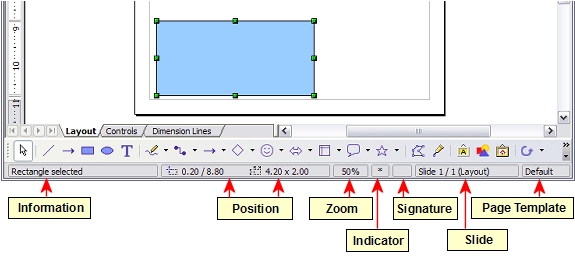
Figure 4: Items on the Draw status bar.
Note: The sizes are given in the current measurement unit (not to be confused with the ruler units). This unit is defined in Tools > Options > OpenOffice.org Draw > General, where you can also change the scale of the page. Another way to change the scale is to double-click on the number shown in the status bar.
- If an object is selected, the left number pair shows the coordinates of the upper left corner and the right number pair the size of the object, as seen in Figure 4. These numbers relate not to the solid object, but to the rectangle forming the selection outline. This outline is the smallest possible rectangle that can contain the visible part or parts of the object; see also Chapter 3.
- When an object is selected, a double-click on this field opens the Position and Size dialog, which is described in detail in Chapter 4.
The percentage shown in the Zoom field gives information about the current zoom factor. A double-click or right-click on this field opens the Zoom dialog where the zoom factor can be quickly changed.
In the Indicator field an asterisk (*) is shown whenever changes have been made to the document but not saved to disk.
If you wish to digitally sign the document, a double-click or right-click in the Signature field brings up the signature box. Note that a document must have been saved at least once before it can be signed. When it is signed an indicator is present in this field.
The Slide field shows the position number of the current drawing page. This is useful when your drawing is made up of a number of pages. If an object is selected, the layer in which it resides within the drawing is also shown. In the example of Figure 4, the object is on the Layout layer of Slide 1.
The Template field shows which page template is being used for the current page. If you have saved several slide designs, you can select one for the current page by double-clicking in this field (see Figure 5) and clicking Load after selecting a slide design.
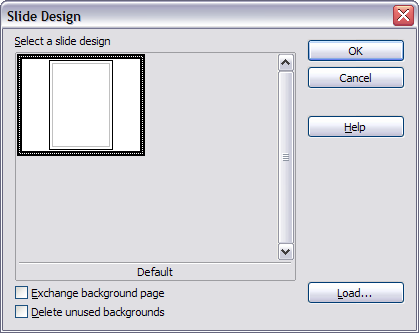
Figure 5: Selecting a slide (page) design.
Toolbars
The various Draw toolbars can be displayed or hidden, according to your needs.
To display or hide the toolbars, click View > Toolbars. On the menu that appears, choose which toolbars you want to display.
You can also select the icons that you wish to appear on the toolbars. Some toolbars have icons that are not displayed by default, but you can choose to display them; you can also hide any icons that do appear on the toolbars by default. To change the visible icons on any toolbar, click the arrow at the right-hand end of the toolbar and select Visible Buttons. On the list of the available tools that appears, select or de-select the icons you want to be visible. A checkmark next to an icon indicates that it will be visible.
Floating toolbars
Many toolbar icons are marked with a small arrow. The arrow indicates that this icon has additional functions. Click the arrow, and a sub-menu or floating toolbar appears, showing its additional functions (see Figure 6).
You may wish to keep this sub-menu displayed on your screen, but in a different position. You can make a sub-menu into a floating toolbar. To do so, click the area at the top of the sub-menu, drag it across the screen, and then release the mouse button. Floating toolbars can be re-docked on an edge of the screen or within one of the existing toolbar areas at the top of the screen, as described in Chapter 4.
Most icons marked with the small arrow can become floating toolbars. The floating toolbar capability is common to all components of the OpenOffice.org suite.
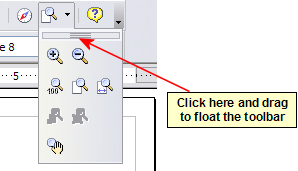
Figure 6: An arrow next to a icon indicates additional functions.
Tip: If you double-click on an icon on a floating toolbar, the command corresponding to that icon is executed. You can then repeat this as often as you like. To exit from this mode, press the Esc key or click on another icon (for example [[Image:]]).
Note: The icon of a floating toolbar always shows the last used command. This can mean that the icon you see on your screen may differ from that shown in this Guide.
Similarly, click on the arrow on the title bar of a floating toolbar to display additional functions (see Figure 7).
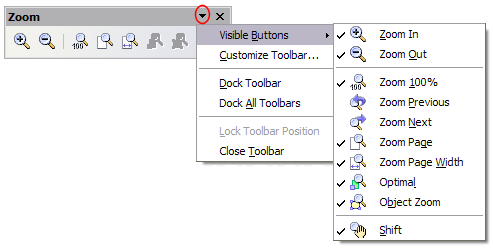
Figure 7: An arrow on a floating toolbar indicates additional functions.
In Draw, as in all components of OpenOffice.org, toolbars can be moved to a new position with the mouse. Hover the mouse over the end of the toolbar (look for two vertical columns of dots) until the cursor becomes two crossed arrows and then drag and drop as desired).
The tools available in the various toolbars are explained in the following sections.
Standard toolbar
The Standard toolbar is the same for all components of OpenOffice.org and is not described in detail here.
Line and Filling toolbar
The Line and Filling toolbar lets you modify the main properties of a drawing object: the icons and pulldown lists vary according to the type of object selected. For example, to change the thickness of a line with the spinner, hover the mouse over the spinner and click the up or down arrow to achieve the desired thickness.
![]()
Figure 9: Line and Filling toolbar.
In the example above, the available functions enable you to change the color, style and width of the line drawn, or the fill color, style, and other properties of an object. The object must first be selected with a mouse click. If the selected object is a text frame, the buttons for line style and fill color are changed to Invisible.
When text is selected, the Line and Filling toolbar changes to the Text Formatting toolbar, which is very similar to the Formatting toolbar in Writer. A more detailed explanation of the buttons on this toolbar can be found in Chapter 4.
![]()
Figure 10: Text Formatting toolbar.
Drawing toolbar
The Drawing toolbar is the most important toolbar in Draw. It contains all the necessary functions for drawing various geometric and freehand shapes and organizing them on the page. It is described in detail in Chapter 2.
Color bar
To display the Color bar, use View > Toolbars > Color Bar. The toolbar then appears at the bottom of the workspace and shows you the current color palette.
This toolbar lets you rapidly choose the color of the various objects—lines, areas, 3D effects—in your drawing. The first box in the panel corresponds to transparency (no color).
You can access several specialised color palettes in Draw as well as change individual colors to your own taste. This is done using the Area dialog, reached by choosing Format > Area as shown in Figure 13, or the pouring can symbol on the Line and Filling toolbar (Figure 9).
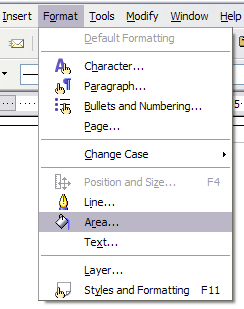
Figure 13: Two ways to display the Area dialog.
On the Area dialog, choose the tab marked Colors (Figure 14).
To load another palette, click on the Load Color List button (circled). The file selector dialog asks you to choose one of the standard OpenOffice.org palettes (files bearing the file extension *.soc). For example, web.soc is a color palette that is particularly adapted to creating drawings that are going to appear in Web pages; the colors will be correctly displayed on workstations with screens displaying at least 256 colors.
A more detailed description of color palettes and their options can be found in Chapter 8.
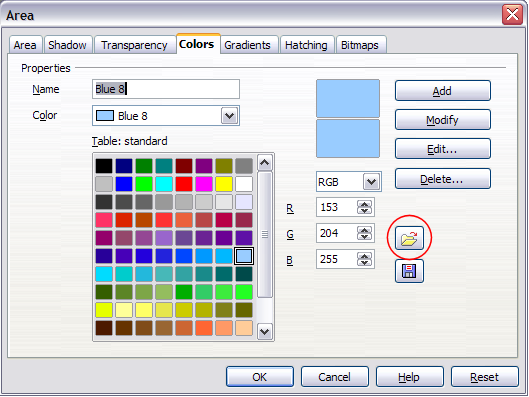
Figure 14. Changing the color palette.
Options toolbar
The Options toolbar lets you activate or deactivate various drawing aids. The Options Bar is not one of the toolbars displayed by default. To display it, select View > Toolbars > Options.
The most important options for starting work in Draw are enclosed in red above. Their functions are described in the table below. The other buttons are described in detail in the relevant chapters of this Guide.
Table 1: Functions on the Options toolbar
| Icon | Function |
| |
Display or hide the Grid |
| |
Display or hide the Guides |
| |
Display or hide Guides when moving |
| |
Snap to Grid |
| |
Snap to Guides |
| |
Snap to Page Margins |
| |
Snap to Object Borders |
| |
Snap to Object Points |
Drawing grid and guides
Draw offers a grid as a drawing aid. The grid can be turned on or off by clicking on the Grid icon on the Options toolbar. The points of the grid displayed on the screen are not shown on the printed drawing. The color, spacing and resolution of the grid points can be individually chosen for each axis. This is described in more detail in Chapter 8 (in the section titled “Configuring the Grid”).
Guides are special “helper lines” that can be turned on or off by clicking on the Guides icon on the Options toolbar. Draw offers a “Snap” function (1), with which you can place drawings exactly on these guides. All snap functions are described in detail in Chapter 8.
Showing the position of the object while moving it makes positioning the object much easier. If this function is activated, pairs of vertical and horizontal lines enclosing the object are shown while moving the object. These lines extend to the edges of the drawing area. This function is also described in detail in Chapter 8.
(1) Drawing objects can be snapped; that is, they can be attached to a grid point, a guide, a page margin, or a border or point of another object.
Customizing toolbars
For greater control, you can add other functions to a toolbar and move tools between toolbars. To do this, in the View > Toolbars menu select Customize, click on the Toolbars tab (see Figure 16), select the toolbar you want to change, and then select the desired buttons for that toolbar. Each toolbar has a different list of buttons.
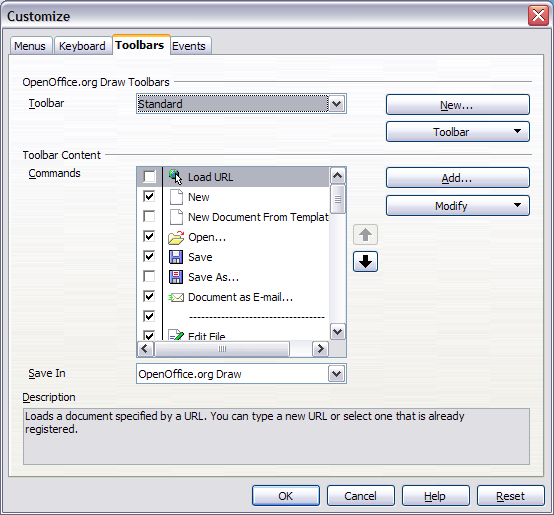
Figure 16: Customizing a toolbar.
| Content on this page is licensed under the Creative Common Attribution 3.0 license (CC-BY). |
